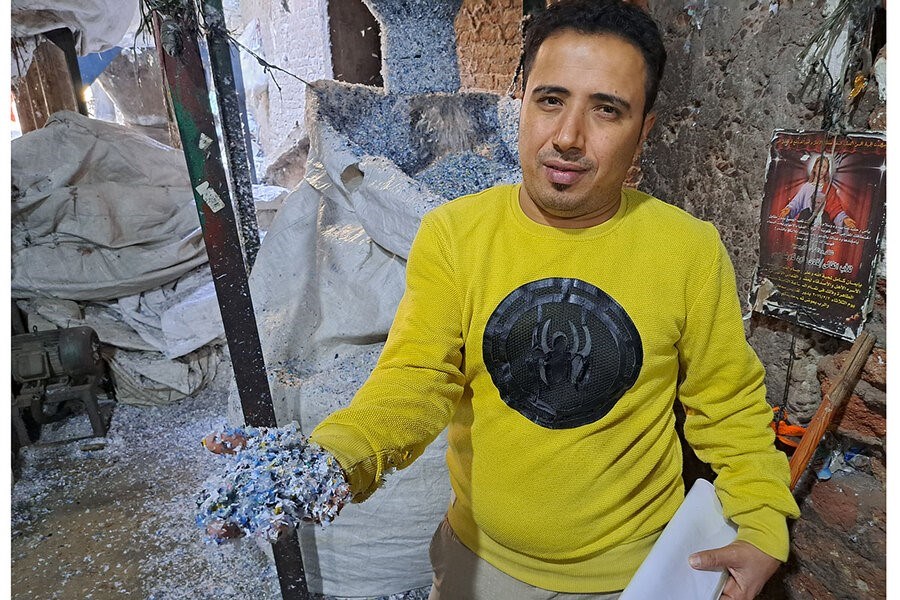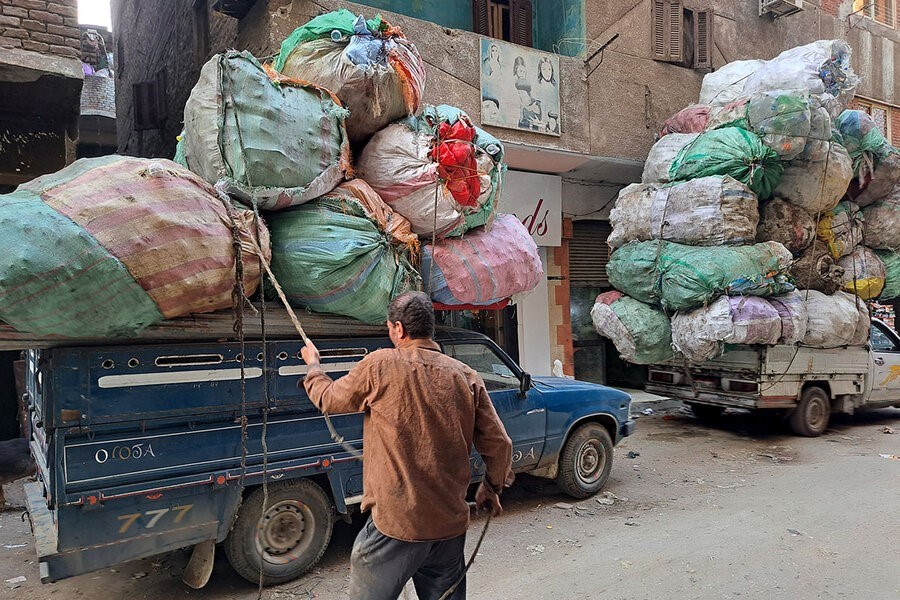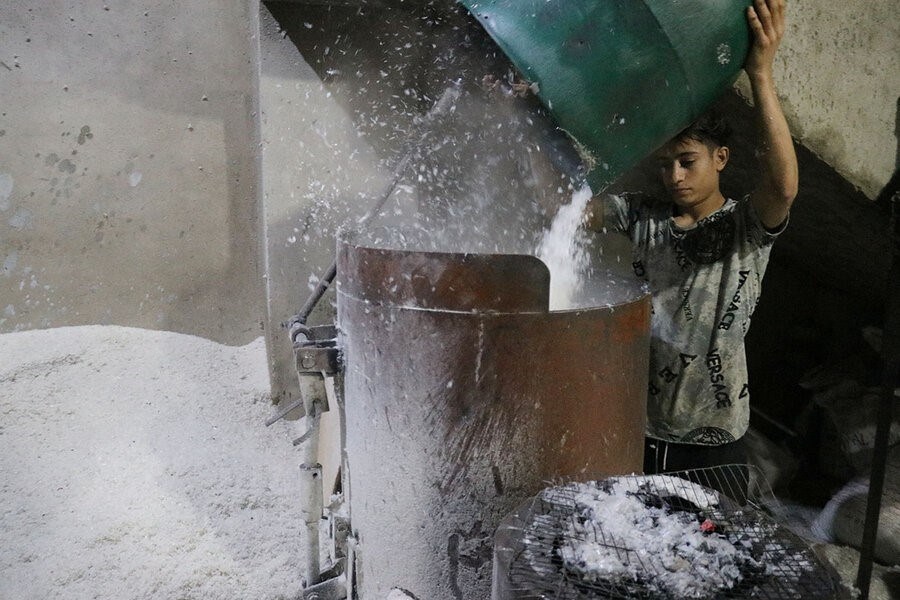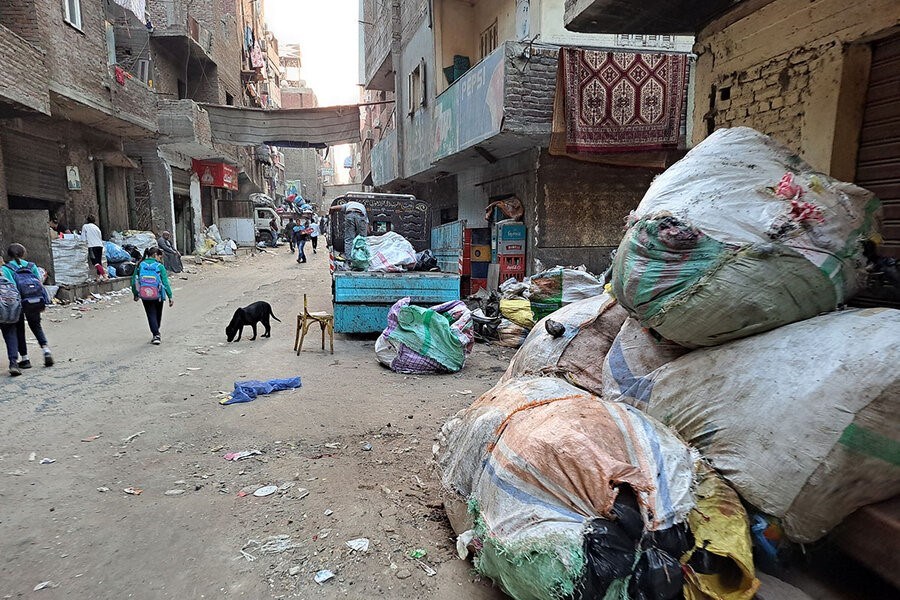REPRINTED WITH PERMISSION FROM THE CHRISTIAN SCIENCE MONITOR
 Moussa Lazmy, supervisor for a recycled bottle project, holds washed and shredded plastic, one of dozens of steps in a comprehensive recycling process, in the Manshiyat Naser neighborhood of Cairo, Nov. 10, 2022.Taylor Luck
Moussa Lazmy, supervisor for a recycled bottle project, holds washed and shredded plastic, one of dozens of steps in a comprehensive recycling process, in the Manshiyat Naser neighborhood of Cairo, Nov. 10, 2022.Taylor Luck
January 19, 2023
In the eastern Cairo neighborhood of Manshiyat Naser, garbage is everywhere: in the streets, piled up in alleyways, in the back of trucks, and even in the hallways of some people’s homes. Its smell is a constant companion.
For some, it’s the smell of opportunity.
“This is a resource, a hidden resource,” says resident Ibrahim Zahi, as he and his workers haul a five-foot stack of pressed plastic onto a grease-covered pickup truck.
One man’s trash is another man’s treasure. It might be a cliché, but it’s a philosophy passed down through generations to Mr. Zahi. And it’s the same ethos that is now powering his community’s emergence as the recycling capital of the Middle East.
There is so much potential treasure, in fact, that 50 of his relatives work in recycling.
“Waste has a value,” Mr. Zahi says. “Plastic here is just like oil and gold.”
By recovering what others cast away, residents in this Cairo enclave are finding something they say many overlook in their daily waste bin: prosperity and a form of dignity.
“People always call us Garbage City and call us ‘garbage people,’” says resident Moussa Lazmy as he peers into a 5-foot-tall bundle of plastic bottles with a checklist in hand. “But this isn’t a city of garbage, this is a recycling city. Everything that comes through here has a purpose and is reused.”
 Taylor LuckA resident fastens bundles of sorted plastic bottles to the back of his truck to be carried to the next stage in the recycling process, in Cairo's Manshiyat Naser neighborhood, Nov. 10, 2022.
Taylor LuckA resident fastens bundles of sorted plastic bottles to the back of his truck to be carried to the next stage in the recycling process, in Cairo's Manshiyat Naser neighborhood, Nov. 10, 2022.
Recycling epicenter
In Manshiyat Naser, the garbage is constantly on the go, moving from station to station – a restless traveler heading to an eco-friendly destination.
More than 14,000 tons of mixed garbage passes through the neighborhood each day. That’s about 85% of all the waste produced by Cairo’s 22 million residents.
Here it is sorted, cleaned, processed, and converted into recycled plastic, or moved on to other factories as recycled raw materials for the production of other goods.
Everyone here in this enclave of 70,000 people has a part to play in the seven stages of recycling: collection, transport, sorting, crushing, washing, processing, and production. There are 8 different jobs involved in every ton of recycled plastic, employing entire families.
Behind Mr. Lazmy, women and teenagers sort mounds of discarded plastic bottles, bags, and other trash by hand in the street; later in the day it will be moved to several washing plants hidden in the honeycomb alleyways before being crushed and processed in the afternoon.
With the around-the-clock caravan of incoming trucks rumbling into Manshiyat Naser packed high with Cairo’s garbage, the hand-sorting, and the churning engines of washing and pressing plants, the sounds of recycling emit a distinctive hum.
New goals, changed perceptions
This predominately Coptic Christian community dates back to the 1920s, when families migrated from their home villages in Upper Egypt and set up camp on what was then the outskirts of Cairo, collecting garbage as feed for their pig farms and to sell as scrap.
Long-stigmatized by the public, for decades residents were referred to as the derogatory zabaleen, or garbage people.
 Taylor LuckA young worker sorts and prepares washed white plastic shreds to be made into recycled plastic sheets in Manshiyat Naser, Egypt, Nov. 10, 2022.
Taylor LuckA young worker sorts and prepares washed white plastic shreds to be made into recycled plastic sheets in Manshiyat Naser, Egypt, Nov. 10, 2022.
But with today’s push for a green economy, sustainability, and climate change awareness, many Egyptians are seeing a new value in the residents’ work, changing perceptions of this maligned neighborhood.
Others also see a business opportunity.
Since 2020, Swiss-multinational food company Nestlé has been working with area residents to collect processed polyethylene terephthalate – one of 100 types of plastic that come through the city – for its recycled rPET bottles.
Mr. Lazmy is one of Nestle’s coordinators, overseeing dozens of collectors, sorters, and processors to move thousands of tons of rPET plastic to a specialized production factory outside Cairo each week.
As Mr. Lazmy, smiling and gregarious, makes his rounds, there is little time for chit-chat; he has to ensure the proper amounts of color-sorted plastic are processed according to EU standards.
“This is the recycling capital of Egypt, and maybe the entire Middle East,” Mr. Lazmy says, counting bundles of crushed green plastic bottles. “It is a reason to feel pride, not shame.”
 Taylor LuckGarbage is everywhere in "Garbage City," the eastern Cairo neighborhood of Manshiyat Naser, Nov. 10, 2022.
Taylor LuckGarbage is everywhere in "Garbage City," the eastern Cairo neighborhood of Manshiyat Naser, Nov. 10, 2022.
Ibrahim, 40, has worked his way up from a teenage garbage sorter to running his own workshop converting washed plastic pellets into clothes hangers used by dry cleaners and five-star hotels across Egypt.
The university graduate says recycling is not below his station.
“I am happy to contribute something to Egypt,” he says as he wipes his brow, eyes fixed on the churning machine molding plastic hangers. “We are making a living and fixing the climate in our own way. I am contributing to society.”
Those who go on to do well elsewhere often come back and reinvest in Recycling City; there are 22 resident-owned pressing and processing plants in the neighborhood.
Ibrahim Zahi worked in recycling in the United Arab Emirates before coming back to Manshiyat Naser, using the savings he earned in the oil-rich Gulf emirates to open his own pressing plant.
Now at his Brahim Zahi Company for Plastic, Mr. Zahi washes and presses plastic at two plants employing 10 area residents and exports recycled plastic bags and flip-flops abroad.
“I feel like an institution; people rely on me,” Mr. Zahi says at his factory.
 Taylor LuckMariam weaves threads of leftover fabric from Egypt's garment factories on her loom, in one of several money-making recycling initiatives in Manshiyat Naser, Nov. 10, 2022.
Taylor LuckMariam weaves threads of leftover fabric from Egypt's garment factories on her loom, in one of several money-making recycling initiatives in Manshiyat Naser, Nov. 10, 2022.
The plastics market
Used plastic is so valuable that Manshiyat Naser residents buy and sell it to each other by the kilogram.
Along with everything in inflation-struck Egypt, the prices of shredded plastic are going up – as of late November it jumped to 25,000 Egyptian Pounds (about $860 dollars) per ton. Washed plastic pellets, highly desired for the production of a range of goods, doubled in price in 2022 alone.
“The recycling economy is like any economy. Even trash goes up in price when transportation and manpower are involved,” Magdy, a processor in his 20s, says as an automatic machine stretches black plastic and cuts it into trash bags.
“Because we here in Manshiyat recognize value in plastics, there is a market and assigned value to each material, which fluctuates.”
“We are entrepreneurs, not scavengers,” says Mr. Zahi.
Such ingenuity is on display at Manshiyat Naser’s Association for the Protection of the Environment, a nongovernmental organization and children’s center that provides educational activities and income for families funded by the creation of patchwork fabrics, rugs, and quilts sewn from unused scraps of fabric and cotton from Egypt’s garment factories.
On a November afternoon, area women were busy at looms, weaving multicolored tapestries and rugs.
“Recycling is not just about finding a new use for something used, there is an art to it,” says weaver Mariam, who gave only her first name, as she pushes the loom’s large wooden beater through the wool threads.
“From leftovers, we can all make something beautiful.”
Hamada Elrasam contributed to this report in Cairo.
Related stories
Page created on 1/29/2023 7:40:44 PM
Last edited 1/29/2023 8:14:16 PM
